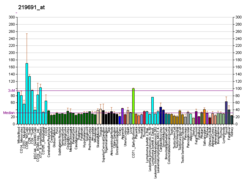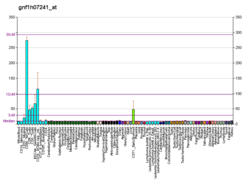Protein-coding gene in the species Homo sapiens
| SAMD9 |
|---|
|
| Identifiers |
|---|
| Aliases | SAMD9, C7orf5, DRIF1, NFTC, OEF1, OEF2, sterile alpha motif domain containing 9, MIRAGE, M7MLS2 |
|---|
| External IDs | OMIM: 610456; HomoloGene: 75072; GeneCards: SAMD9; OMA:SAMD9 - orthologs |
|---|
| Gene location (Human) |
|---|
 | | Chr. | Chromosome 7 (human)[1] |
|---|
| | Band | 7q21.2 | Start | 93,099,513 bp[1] |
|---|
| End | 93,118,023 bp[1] |
|---|
|
| RNA expression pattern |
|---|
| Bgee | | Human | Mouse (ortholog) |
|---|
| Top expressed in | - amniotic fluid
- oral cavity
- buccal mucosa cell
- mucosa of pharynx
- gums
- gingival epithelium
- palpebral conjunctiva
- decidua
- epithelium of nasopharynx
- trabecular bone
|
| | | More reference expression data |
|
|---|
| BioGPS | 
 | | More reference expression data |
|
|---|
|
| Gene ontology |
|---|
| Molecular function | | | Cellular component | - cytoplasm
- intracellular membrane-bounded organelle
- cytosol
- early endosome
| | Biological process | | | Sources:Amigo / QuickGO |
|
| Orthologs |
|---|
| Species | Human | Mouse |
|---|
| Entrez | | |
|---|
| Ensembl | | |
|---|
| UniProt | | |
|---|
| RefSeq (mRNA) | | |
|---|
| RefSeq (protein) | | |
|---|
| Location (UCSC) | Chr 7: 93.1 – 93.12 Mb | n/a |
|---|
| PubMed search | [2] | n/a |
|---|
|
| Wikidata |
|
Sterile alpha motif domain-containing protein 9 is a 1,589-amino-acid protein encoded by the SAMD9 gene.[3] This cytoplasmic protein is a tumor suppressor that has a role in cell proliferation and the innate immune response to viral infection. Like its paralog, SAMD9-like (SAMD9L) protein,[4] its N-terminus contains a sterile alpha motif (SAM).
Deleterious mutations of this gene cause normophosphatemic familial tumoral calcinosis (NFTC).[4] On the other hand, mutations that increase the activity of SAMD9 cause myelodysplasia, infection, restriction of growth, adrenal hypoplasia (small adrenal glands with diminished function), genital phenotypes, and enteropathy (MIRAGE) syndrome.[5] This can lead to loss of chromosome 7 as described for monosomy 7 and myelodysplastic syndrome and leukemia syndrome-2 (M7MLS2).[6] Loss of chromosome 7/7q may be an adaptation to a growth restriction inherent in SAMD9/9L mutant cells.[7]
References
- ^ a b c GRCh38: Ensembl release 89: ENSG00000205413 – Ensembl, May 2017
- ^ "Human PubMed Reference:". National Center for Biotechnology Information, U.S. National Library of Medicine.
- ^ "Entrez Gene: SAMD9 sterile alpha motif domain containing 9".
- ^ a b Topaz et al. 2006
- ^ Narumi S, Amano N, Ishii T, Katsumata N, Muroya K, Adachi M, et al. (July 2016). "SAMD9 mutations cause a novel multisystem disorder, MIRAGE syndrome, and are associated with loss of chromosome 7". Nature Genetics. 48 (7): 792–7. doi:10.1038/ng.3569. PMID 27182967. S2CID 13270706.
- ^ Schwartz JR, Wang S, Ma J, Lamprecht T, Walsh M, Song G, et al. (August 2017). "Germline SAMD9 mutation in siblings with monosomy 7 and myelodysplastic syndrome". Leukemia. 31 (8): 1827–30. doi:10.1038/leu.2017.142. PMC 5540771. PMID 28487541.
- ^ Hall T, Gurbuxani S, Crispino JD. Malignant progression of preleukemic disorders. Blood. 2024 May 30;143(22):2245-2255. doi: 10.1182/blood.2023020817. PMID: 38498034; PMCID: PMC11181356.
Further reading
- Maruyama K, Sugano S (January 1994). "Oligo-capping: a simple method to replace the cap structure of eukaryotic mRNAs with oligoribonucleotides". Gene. 138 (1–2): 171–4. doi:10.1016/0378-1119(94)90802-8. PMID 8125298.
- Suzuki Y, Yoshitomo-Nakagawa K, Maruyama K, Suyama A, Sugano S (October 1997). "Construction and characterization of a full length-enriched and a 5'-end-enriched cDNA library". Gene. 200 (1–2): 149–156. doi:10.1016/S0378-1119(97)00411-3. PMID 9373149.
- The Sanger Centre; The Washington University Genome Sequencing Center (November 1998). "Toward a complete human genome sequence". Genome Research. 8 (11): 1097–1108. doi:10.1101/gr.8.11.1097. PMID 9847074.
- Topaz O, Indelman M, Chefetz I, Geiger D, Metzker A, Altschuler Y, et al. (October 2006). "A deleterious mutation in SAMD9 causes normophosphatemic familial tumoral calcinosis". American Journal of Human Genetics. 79 (4): 759–764. doi:10.1086/508069. PMC 1592555. PMID 16960814.
- Li CF, MacDonald JR, Wei RY, Ray J, Lau K, Kandel C, et al. (April 2007). "Human sterile alpha motif domain 9, a novel gene identified as down-regulated in aggressive fibromatosis, is absent in the mouse". BMC Genomics. 8: 92. doi:10.1186/1471-2164-8-92. PMC 1855325. PMID 17407603.
- Dereure O (May 2007). "[SAMD9 mutation in normophosphatemic familial tumoral calcinosis]". Annales de Dermatologie et de Vénéréologie. 134 (5 Pt 1): 505. doi:10.1016/S0151-9638(07)89230-1. PMID 17507861.

















